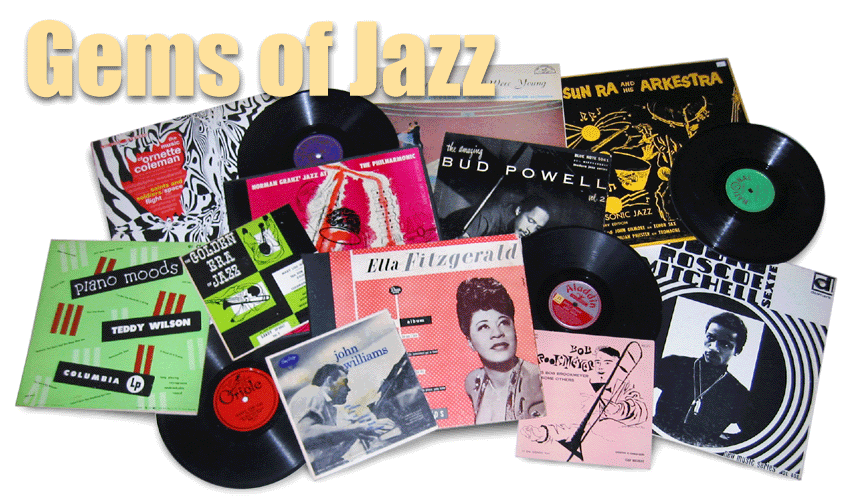 |
| Wardell Gray was a participant in his last years in numerous West Coast jam sessions, and not just those organized by Norman Granz. Here he solos with altoist Frank Morgan and trumpeter Ernie Royal somewhere in Los Angeles in 1951. Photo by William Claxton |
While digging through the stacks the other day, I came across a 10-incher that I'd forgotten I had – which is not unusual these days. I'd bought it many years ago in a Chicago used record store that occasionally had some interesting sides. This one was an EP on the Tops Masterpiece label, another cheapo '50s reprint outfit that mostly issued pop music covers by faceless studio orchestras. But this disc was different.
Called "Junior Jazz at the Auditorium," it featured a quartet of tunes by the likes of Howard McGhee, Lucky Thompson and Jack McVea and was obviously a jam session of the Jazz-at-the-Philharmonic variety. But "Junior Jazz"? That sophomoric title required a bit of looking into.
 |
| Pasadena's Civic Auditorium |
My trusty friend, Walter Bruyninckx, whose invaluable jazz discography I was fortunate enough to purchase back in 1980, supplied the details. This Junior Jazz date was actually a jazz jam session and dance held at the Pasadena Civic Auditorium in 1946, several years after Norman Granz's first JATP show. It was modeled on Granz's concept and was recorded by pioneer A&R man and producer Ralph Bass for the Black & White record label. Bass started out in jazz, but soon moved on to the burgeoning R&B genre. His single greatest achievement was the signing of the then-unknown James Brown to Syd Nathan's King Records, a deed for which the short-sighted Nathan promptly fired Bass.
 |
| Ralph Bass in 1960 |
Finding this EP again got me thinking about the other JATP-type shows that occurred in the wake Granz's success. Gene Norman and his "Just Jazz" releases also came to mind, and I decided I'd make this posting about the JATP-wannabes.
In the 1940s, Norman was a jazz DJ in Hollywood who aspired to greater things. He began producing concerts under the rubric "Just Jazz," and like Granz before him, recorded them for his own use. His shows included stars like Lionel Hampton, Dixielanders like Teddy Buckner, and young modernists like Max Roach and Clifford Brown. One thing led to another, and soon Norman was leasing his dubs for commercial release. He eventually formed his own record label, GNP Crescendo, and launched a four-decade career as a record producer. While quality and continuity were never GNP Crescendo's strong suit, there's a lot of good music on the label.
 |
| Gene Norman |
For this offering I've pulled selections from two separate Just Jazz concerts, one from 1947 and another from a bit later in the year (although Downbeat, in a contemporaneous review, said it was from 1948). They've been reissued several times over the decades, mostly on budget labels, but here they're from two Crown Records editions. In both cases, the Just Jazz selections were packaged with tunes from other dates and places, but those have been omitted. It's just Just Jazz.
The jazz greats featured on these sides include Wardell Gray, the aforementioned Howard McGhee, Stan Getz, Red Norvo, Dodo Marmarosa, the Nat Cole Trio and many others. The rarer Junior Jazz set showcases the superb Lucky Thompson and is worth grabbing for that reason alone. But there's another surprise on that disc – the alto player. I'd assumed it was Willie Smith – it sounded like Willie Smith – but the reference books (Bruyninckx) list the player as one Les Robinson. He turns out to be the guy who played lead alto on Artie Shaw's "Begin the Beguine." If the altoist is indeed Mr. Robinson, he was one heck of a player!
 |
| Ouch! |
One other thing. As I was making the dubs for this posting, I noticed to my horror that the Junior Jazz disc had a fine crack running through half of it. It was quite audible, and that meant only one thing – Gems had to digitally remove each and every one of those pesky clicks by hand. Not to worry, though – the sound is now very clean throughout. Don't say I never did anything for you ...
So here's a concert of live jazz jams from the '40s showcasing a number of players who never made it to a Jazz at the Philharmonic show. All the material is rare, and I don't believe the Junior Jazz tunes have ever been reissued. For an added treat, Ralph Bass himself introduces those performances in a studio overdub. The cover's a hoot, too. I've given you just the album fronts as the backsides are simply listings of other schlocky LPs available on the respective labels.
As always, these tunes have been ripped from the original vinyl with, in this case, LOTS of cleaning up of the sound.
The Other JATPs
Junior Jazz at the Auditorium
Howard McGhee, tp: Jack McVea, Lucky Thompson, ts; Les Robinson, as; Jimmy Bunn, p; Irving Ashby, g; Red Callender, b; Jackie Mills, d.
Pasadena Civic Auditorium, Pasadena, CA; 1946
Tops Masterpiece L928 (originally Black & White)
1. Sunny Side of the Street
2. What Is This Thing Called Love? (Hot House)
3. Body and Soul
4. Lover Come Back to Me
Gene Norman Presents Just Jazz
Howard McGhee, tp; Sonny Criss, as; Wardell Grey, ts; Dodo Marmarosa, p; Red Callender, b; Jackie Mills, d.
Hollywood, CA; April 29, 1947
Crown CLP 5415
5. Groovin' High
Same date, personnel; omit Callender, add Charlie Drayton, b.
Crown CLP 5408
6. Hot House
Charlie Shavers, tp; Willie Smith, as; Stan Getz, ts; Red Norvo, vbs; Nat Cole, p; Oscar Moore, g; Johnny Miller, b; Louis Bellson, d.
Hollywood, CA; June 23, 1947
Crown CLP 5408
7. How High the Moon
Find it here: http://www.mediafire.com/download/vb23h92csot409s/The_Other_JATPs.rar

















